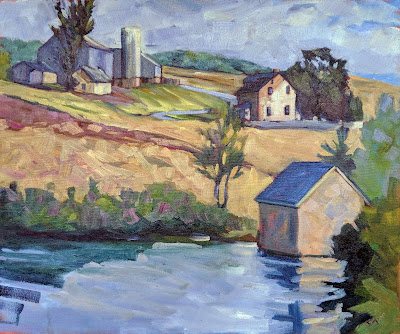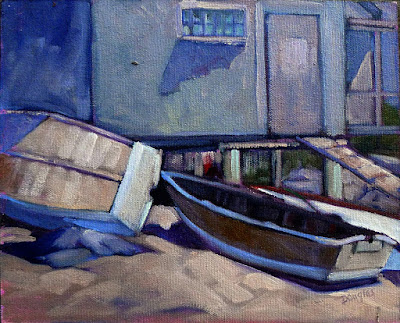Boats, mountains, glaciers—I like painting off the beaten path.
I don’t worry about much, but setting up the coffee this morning I was stopped by the sound of running water near the sink. It was rainwater coursing down the window in great gouts. Not a domestic problem, but it’s a hard start for the inaugural Camden on Canvas, which has brought top-tier artists to paint in our little burg.
Camden on Canvas is the pet project of Colin Page, and it’s a fundraiser for the Camden Public Library. Colin’s got bigger worries this morning than where he himself will paint. Anyway, he could paint Camden harbor blindfolded and with a sling on his good arm—after all, it’s his home harbor. As for the rest of us, we’re professionals, and we have two days to finish our paintings.
I’ll be heading down to Camden a little later this morning and setting up on the docks on the harbormaster’s side. I’ll work on a harbor painting today, but tomorrow my real adventure starts. I’m climbing to the top of Bald Mountain early in the morning and painting the vista of Camden from a high peak. Any fool can drive up Mt. Battie and paint from the parking area at the summit, but it makes a mediocre picture, having no foreground. Bald Mountain is a 2.6-mile round-trip hike of moderate difficulty (although it will be slippery after all this rain).
 |
| View from Bald Mountain. |
If you plan to go up there to watch me paint, bring your own chair. I’m not carrying one up for you. You don’t have to work that hard, however; last time I checked, the signal on Bald Mountain was great. I’ll live-broadcast my painting on Facebook. It’s hard to predict an exact time, but expect me to start early, while the sun is still low in the east. I’ll update times on my Facebook page.
Speaking of video, my friend and student Terri Lea Smith made this wonderful video of schooner American Eagleduring our June workshop. If you’ve ever wondered why I have a crush on this particular boat, her film should answer that question. Boats, mountains, glaciers—I like painting off the beaten path.
On that note, students interested in my Pecos workshop might be happy to learn that Our Lady of Guadalupe Abbeyhas added camping spots to their accommodations. It’s a stunning location along the Pecos River and very convenient to all our painting sites. If you’re interested, I’d call them—quickly—at 505-757-6415. And then let me know, too.
 |
| My 2020 painting for Cape Elizabeth’s Paint for Preservation. |
Cape Elizabeth’s Paint for Preservation is August 13-15. We’re assigned sites to paint, and these came this week. I’ll be at Trundy Point, which is a massive rock jutting out into the ocean. It’s got surf, beach roses, scree, and beautiful rocks.
I’ll only be there on Saturday, as I’m finishing my workshop in Schoodic that Friday. That occasional problem of unavoidable schedule conflicts is another reason they give us two days to paint at these events. As you can imagine, I’m praying for no rain.




























